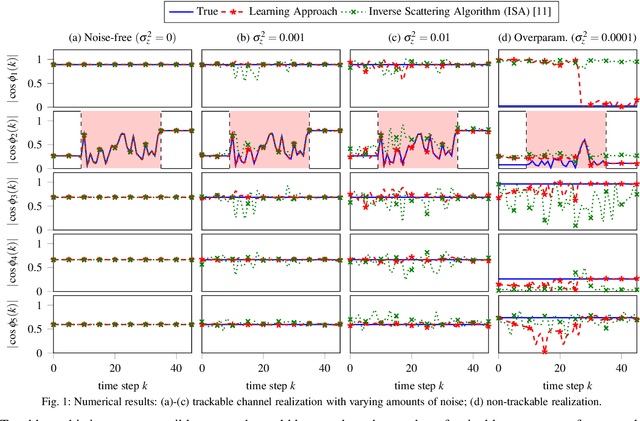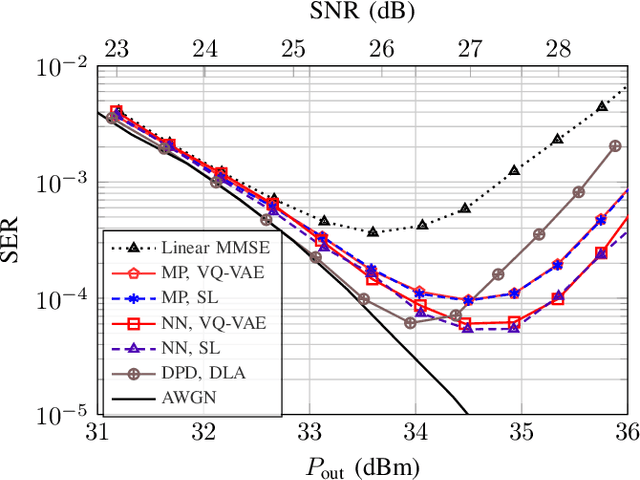Christian Häger
Unsupervised Learning for Gain-Phase Impairment Calibration in ISAC Systems
Oct 05, 2024



Abstract:Gain-phase impairments (GPIs) affect both communication and sensing in 6G integrated sensing and communication (ISAC). We study the effect of GPIs in a single-input, multiple-output orthogonal frequency-division multiplexing ISAC system and develop a model-based unsupervised learning approach to simultaneously (i) estimate the gain-phase errors and (ii) localize sensing targets. The proposed method is based on the optimal maximum a-posteriori ratio test for a single target. Results show that the proposed approach can effectively estimate the gain-phase errors and yield similar position estimation performance as the case when the impairments are fully known.
Decoding Quantum LDPC Codes Using Graph Neural Networks
Aug 09, 2024Abstract:In this paper, we propose a novel decoding method for Quantum Low-Density Parity-Check (QLDPC) codes based on Graph Neural Networks (GNNs). Similar to the Belief Propagation (BP)-based QLDPC decoders, the proposed GNN-based QLDPC decoder exploits the sparse graph structure of QLDPC codes and can be implemented as a message-passing decoding algorithm. We compare the proposed GNN-based decoding algorithm against selected classes of both conventional and neural-enhanced QLDPC decoding algorithms across several QLDPC code designs. The simulation results demonstrate excellent performance of GNN-based decoders along with their low complexity compared to competing methods.
Learning to Extract Distributed Polarization Sensing Data from Noisy Jones Matrices
Jan 18, 2024
Abstract:We consider the problem of recovering spatially resolved polarization information from receiver Jones matrices. We introduce a physics-based learning approach, improving noise resilience compared to previous inverse scattering methods, while highlighting challenges related to model overparameterization.
Blind Frequency-Domain Equalization Using Vector-Quantized Variational Autoencoders
Dec 26, 2023


Abstract:We propose a novel frequency-domain blind equalization scheme for coherent optical communications. The method is shown to achieve similar performance to its recently proposed time-domain counterpart with lower computational complexity, while outperforming the commonly used CMA-based equalizers.
Semi-Supervised End-to-End Learning for Integrated Sensing and Communications
Oct 15, 2023



Abstract:Integrated sensing and communications (ISAC) is envisioned as one of the key enablers of next-generation wireless systems, offering improved hardware, spectral, and energy efficiencies. In this paper, we consider an ISAC transceiver with an impaired uniform linear array that performs single-target detection and position estimation, and multiple-input single-output communications. A differentiable model-based learning approach is considered, which optimizes both the transmitter and the sensing receiver in an end-to-end manner. An unsupervised loss function that enables impairment compensation without the need for labeled data is proposed. Semi-supervised learning strategies are also proposed, which use a combination of small amounts of labeled data and unlabeled data. Our results show that semi-supervised learning can achieve similar performance to supervised learning with 98.8% less required labeled data.
Model-Based End-to-End Learning for Multi-Target Integrated Sensing and Communication
Jul 09, 2023



Abstract:We study model-based end-to-end learning in the context of integrated sensing and communication (ISAC) under hardware impairments. A monostatic orthogonal frequency-division multiplexing (OFDM) sensing and multiple-input single-output (MISO) communication scenario is considered, incorporating hardware imperfections at the ISAC transceiver antenna array. To enable end-to-end learning of the ISAC transmitter and sensing receiver, we propose a novel differentiable version of the orthogonal matching pursuit (OMP) algorithm that is suitable for multi-target sensing. Based on the differentiable OMP, we devise two model-based parameterization strategies to account for hardware impairments: (i) learning a dictionary of steering vectors for different angles, and (ii) learning the parameterized hardware impairments. For the single-target case, we carry out a comprehensive performance analysis of the proposed model-based learning approaches, a neural-network-based learning approach and a strong baseline consisting of least-squares beamforming, conventional OMP, and maximum-likelihood symbol detection for communication. Results show that learning the parameterized hardware impairments offers higher detection probability, better angle and range estimation accuracy, lower communication symbol error rate (SER), and exhibits the lowest complexity among all learning methods. Lastly, we demonstrate that learning the parameterized hardware impairments is scalable also to multiple targets, revealing significant improvements in terms of ISAC performance over the baseline.
Blind Channel Equalization Using Vector-Quantized Variational Autoencoders
Feb 22, 2023



Abstract:State-of-the-art high-spectral-efficiency communication systems employ high-order modulation formats coupled with high symbol rates to accommodate the ever-growing demand for data rate-hungry applications. However, such systems are more vulnerable to linear and nonlinear transmission impairments, and it is important to mitigate the performance loss via digital signal processing. In this paper, we propose a novel machine learning approach for blind channel equalization and estimation using the vector quantized (VQ) \ac{VAE} framework. The proposed approach generalizes the applicability of the conventional \ac{VAE}-based equalizer to nonlinear systems employing high-order modulation formats by introducing a codebook component and an associated novel loss function. We evaluate the performance of the proposed method over a linear additive white Gaussian noise channel with intersymbol interference and two nonlinear scenarios. Simulation results show that the proposed method can achieve similar performance as a data aided equalizer using the \acf{MMSE} criterion, and outperforms the blind\ac{CMA} and the \ac{VAE}-based channel equalizer. Furthermore, we show that for the linear channel, the proposed scheme exhibits better convergence properties than the \ac{MMSE}-based, the \ac{CMA}-based, and the \ac{VAE}-based equalizers in terms of both convergence speed and robustness to variations in training batch size and learning rate.
Rateless Autoencoder Codes: Trading off Decoding Delay and Reliability
Jan 31, 2023



Abstract:Most of today's communication systems are designed to target reliable message recovery after receiving the entire encoded message (codeword). However, in many practical scenarios, the transmission process may be interrupted before receiving the complete codeword. This paper proposes a novel rateless autoencoder (AE)-based code design suitable for decoding the transmitted message before the noisy codeword is fully received. Using particular dropout strategies applied during the training process, rateless AE codes allow to trade off between decoding delay and reliability, providing a graceful improvement of the latter with each additionally received codeword symbol. The proposed rateless AEs significantly outperform the conventional AE designs for scenarios where it is desirable to trade off reliability for lower decoding delay.
Model-Driven End-to-End Learning for Integrated Sensing and Communication
Dec 20, 2022Abstract:Integrated sensing and communication (ISAC) is envisioned to be one of the pillars of 6G. However, 6G is also expected to be severely affected by hardware impairments. Under such impairments, standard model-based approaches might fail if they do not capture the underlying reality. To this end, data-driven methods are an alternative to deal with cases where imperfections cannot be easily modeled. In this paper, we propose a model-driven learning architecture for joint single-target multi-input multi-output (MIMO) sensing and multi-input single-output (MISO) communication. We compare it with a standard neural network approach under complexity constraints. Results show that under hardware impairments, both learning methods yield better results than the model-based standard baseline. If complexity constraints are further introduced, model-driven learning outperforms the neural-network-based approach. Model-driven learning also shows better generalization performance for new unseen testing scenarios.
FPGA Implementation of Multi-Layer Machine Learning Equalizer with On-Chip Training
Dec 07, 2022



Abstract:We design and implement an adaptive machine learning equalizer that alternates multiple linear and nonlinear computational layers on an FPGA. On-chip training via gradient backpropagation is shown to allow for real-time adaptation to time-varying channel impairments.
 Add to Chrome
Add to Chrome Add to Firefox
Add to Firefox Add to Edge
Add to Edge